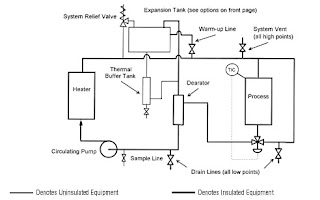 |
| Add caption |
The need for deaeration
In marine water tube boilers it is essential to keep water free of dissolved gases and impurities to prevent serious damage occurring in the boiler In a closed feed system the regenerative condenser removes the bulk of the gases with a dissolved oxygen content of less than 0.02 ml/lHowever, it is recommended for boilers operating above 30 bar and essential for those operating above 42 bar that a dearator be fitted.
Purpose of fitting a Deaerator
- To act as a storage tank so as to maintain a level of water in the system
- To keep a constant head on the feed system and in particularly the Feed pumps.
- Allow for mechanical deaeration of the water
- Act as a contact feed heater.
-
There are four main purposes;
Feed water enters the dearator via the vent cooler, here the non condensible gasses and a small amount of steam vapour are cooled. The condensed water is returned to the system. The feed water is sprayed into the mixing chamber via nozzles, for systems with large variations of flow, two separate nozzle boxes may fitted with two independent shut off valves to ensure sufficient pressure for efficient spray.
Alternatively, automatic spray valves may be fitted.
By varying the spring tension the pressure at which the nozzles open can be set at different levels.
The water in a fine spray, and so high surface area to volume, is rapidly heated to corresponding saturation temperature in the mixing chamber by the heating steam. This steam is supplied from the exhaust or IP system and is at about 2.5 bar.
The heated water and condensed steam then falls onto a series of plates with serrated edges, the purpose of these is to mechanically remove any gas bubbles in the water improving the efficiency of the process.
Finally the water falls into the buffer tank, before exiting to the feed pumps; as the water is now at saturation temperature any drop in pressure (such as in the suction eye of the impeller ) will cause vapour bubbles to form. Hence, the deaerator must be fitted well above the feed pumps or alternatively an extraction pump must be fitted to supply the feed pumps.
Hot water drains are led to the dearator where they are allowed to flash into steam adding to the heating steam.
The non condensible gas outlet is limited so that there is only a small flow of water from the drain of the cooler. This water should be discarded as it contains not only high quantities of oxygen but also ammonia.
- Requirements for efficient operation
- The minimum temperature increase is 28oC
- The minimum heating steam temperature is 115oC which corresponds to a pressure of 1.7 bar; this is to prevent deposits forming on the economiser. To prevent cold end corrosion on cast iron protected economisers this temperature rises leading to the common practice of using steam at 2.5 bar
- The water at inlet should have an oxygen content of not more than 0.02 ml/l
A thermometer is fitted to the shell, the temperature should be kept to within 4oC of the saturation temperature of the pressure indicated on the pressure gauge. This can be governed by the quantity of heating steam added. If the difference is always greater the partial pressure due to the non-condensable gasses is high and the possibility of redissolving increases. Where fitted the valve on the air outlet should be opened more to limit of too much steam being lost up the vent.
The fitting of vent condensers is not universal and it is not uncommon to see the vent led up the funnel where a small wisp of steam can be seen when correctly adjusted.
No comments:
Post a Comment